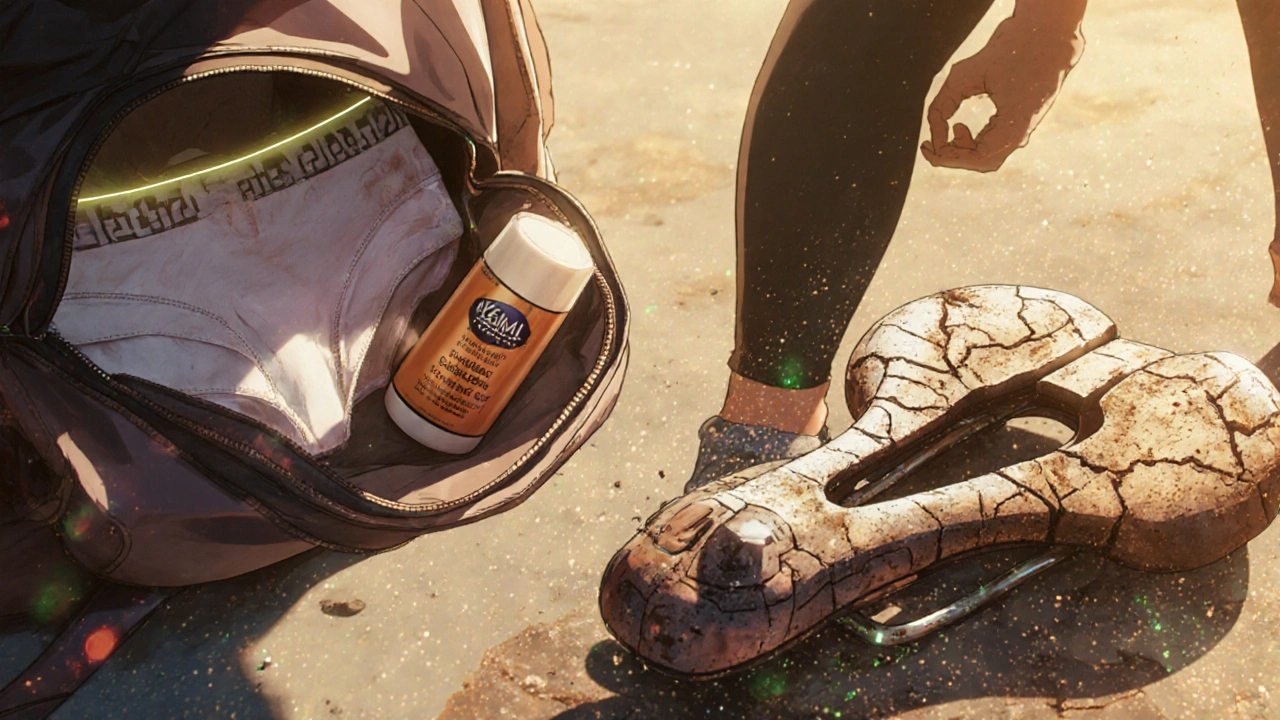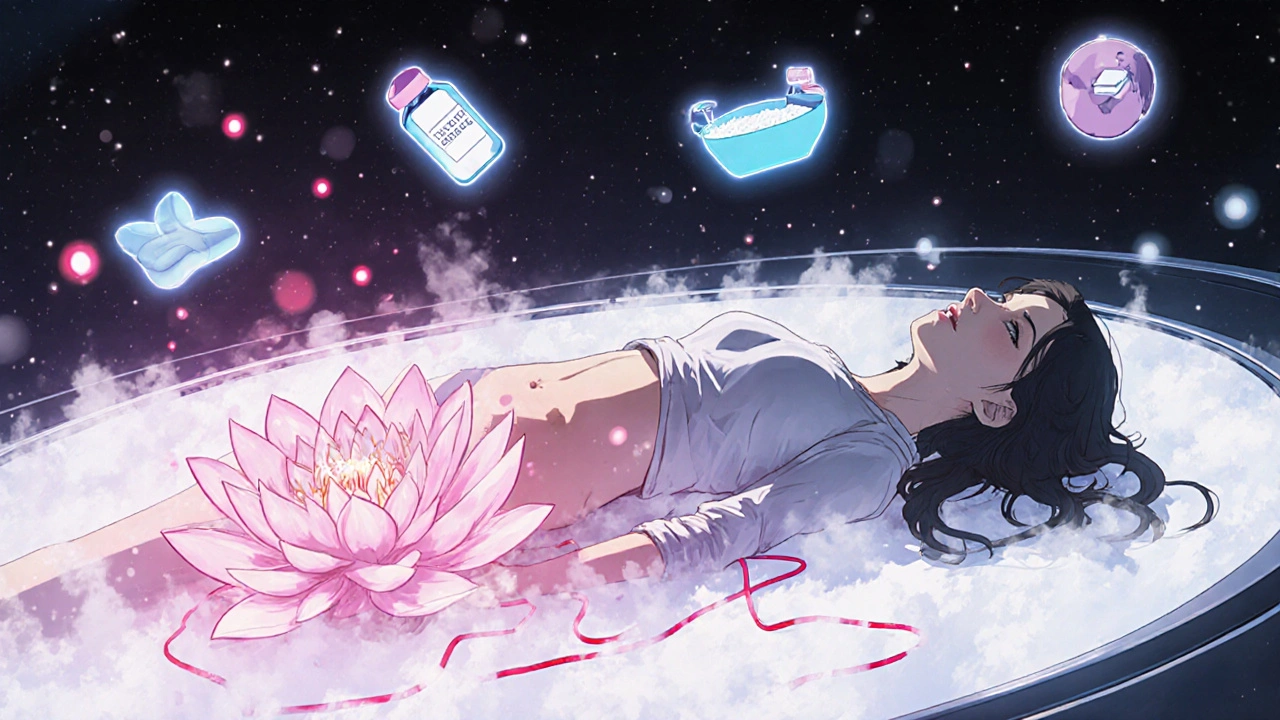Many women notice vaginal burning after working out-whether it’s after a high-intensity class, a long run, or even just a brisk walk. It’s not normal, but it’s also not rare. If you’ve felt that stinging, raw, or itchy sensation down there after sweating, you’re not alone. And no, it’s not just in your head. Exercise can directly trigger or worsen vaginal burning, but the good news is, you can often fix it without stopping your routine.
Why Exercise Causes Vaginal Burning
Vaginal burning after exercise usually comes down to three things: friction, moisture, and pH imbalance. Your vaginal area is sensitive. It’s not designed to rub against synthetic fabric for 45 minutes while soaked in sweat. When you move-especially during cycling, running, or HIIT-your inner thighs and vulva rub together. Add tight leggings, a poorly fitted sports bra, or a non-breathable pad, and you’ve created the perfect storm.
Sweat isn’t just water. It contains salt, urea, and bacteria. When it sits against the skin, it breaks down the natural protective barrier. The vagina maintains a slightly acidic pH (between 3.8 and 4.5) to keep harmful bacteria in check. Sweat is neutral to slightly alkaline. When it pools in the area, it raises the pH, letting yeast and other irritants grow. That’s when burning, itching, or even a mild odor shows up.
Some women also notice this after starting a new workout routine. If you’ve added more squats, lunges, or core work, you might be engaging your pelvic floor muscles harder than before. Overactive or tight pelvic floor muscles can refer pain as burning. It’s not an infection-it’s muscle tension mimicking one.
Common Triggers in Your Workout Gear
What you wear matters more than you think. Many women assume all “athletic” fabrics are equal. They’re not.
- Spandex and polyester blends trap heat and moisture. They’re great for compression, terrible for breathability.
- Non-cotton underwear under leggings? That’s a problem. Even if the leggings are moisture-wicking, the underwear underneath isn’t.
- Thongs can push sweat and bacteria directly into the vaginal opening. They’re not designed for high-sweat activities.
- Old or worn-out workout clothes lose their wicking ability. They hold onto bacteria and sweat like a sponge.
Real example: A 34-year-old runner in Perth noticed burning every time she ran more than 5km. She switched from synthetic underwear to 100% organic cotton, wore looser shorts instead of tights on long runs, and changed immediately after her workout. The burning stopped within three days.
Exercise Types That Are More Likely to Cause Irritation
Not all workouts are equal when it comes to vaginal discomfort.
- Cycling-especially stationary bikes or road biking with a narrow saddle-puts direct pressure on the perineum. This can compress nerves and blood flow, leading to numbness, tingling, or burning.
- High-impact cardio (jump rope, box jumps, burpees) causes repeated bouncing that can irritate sensitive skin.
- Yoga or Pilates with deep hip openers can stretch the pelvic floor in ways that trigger referred pain if muscles are already tight.
- Weight training with heavy squats increases intra-abdominal pressure, which can push vaginal tissue downward and cause friction or irritation.
On the flip side, low-impact activities like walking, swimming (in clean, chlorinated pools), or using an elliptical are far less likely to cause issues. Swimming can even help rinse away irritants-just make sure you change out of your wet suit right after.

How to Prevent Vaginal Burning During Exercise
You don’t have to give up your fitness goals. Here’s how to keep your workouts safe and comfortable.
- Change out of sweaty clothes within 30 minutes after working out. Don’t sit in damp leggings. Even a 10-minute delay can let irritation take root.
- Wear breathable cotton underwear under your activewear. Avoid seamless or synthetic options. Look for underwear labeled “for sensitive skin” or “medically tested.”
- Use a moisture-wicking, non-scented pad only if needed. Many women don’t need them. If you do, choose unscented, hypoallergenic options without plastic backing.
- Apply a thin layer of barrier cream before exercise. Products like zinc oxide or medical-grade petroleum jelly (plain, no additives) can reduce friction. Avoid scented lotions or oils.
- Stay hydrated. Dehydration makes sweat more concentrated, which increases irritation. Drink water before, during, and after your workout.
- Check your bike saddle if you cycle. A wider, well-padded saddle with a cutout can reduce pressure. Adjust the height so your hips don’t rock side to side.
When Vaginal Burning Might Be Something Else
Not every case of burning after exercise is caused by friction or sweat. Sometimes, it’s a sign of an underlying condition.
If you have:
- Burning that lasts more than 48 hours after your workout
- Unusual discharge (thick, white, yellow, or green)
- Pain during urination or sex
- Redness, swelling, or sores
…then it’s not just irritation. It could be:
- Bacterial vaginosis-caused by an imbalance of vaginal bacteria. Often smells fishy.
- Yeast infection-intense itching, thick white discharge, burning that worsens after sex or during your period.
- Vulvodynia-chronic pain without infection. Can be triggered by pressure or movement.
- Sexually transmitted infections like chlamydia or trichomoniasis.
If symptoms persist or come back after changing your routine, see a women’s health provider. Don’t assume it’s “just from working out.”

Strengthening Your Pelvic Floor Can Help-But Only If Done Right
Many women think Kegels are the answer to everything. But if your pelvic floor is already too tight, doing more Kegels can make burning worse.
Instead of just squeezing, focus on relaxing the pelvic floor. Try this simple technique: Lie on your back with knees bent. Breathe in slowly through your nose, letting your belly rise. As you exhale, imagine your pelvic floor softening-like a flower opening. Do this for 5 minutes a day. It’s called diaphragmatic breathing with pelvic floor release.
Physical therapists who specialize in pelvic health can assess whether your muscles are overactive. They can teach you how to release tension without weakening them. This isn’t about doing more-it’s about doing it smarter.
What to Do If You’re Already Burning
Once the burning starts, don’t ignore it. Here’s what works:
- Cool compress-dampen a clean cloth with cool water and hold it gently against the area for 10 minutes. Don’t use ice.
- Warm salt bath-add 1 cup of Epsom salt to a shallow bath. Soak for 15 minutes. This soothes irritation and draws out excess moisture.
- Stop using scented products-no bubble bath, vaginal sprays, or scented wipes. Even “natural” essential oils can irritate.
- Take a break from high-impact exercise for 2-3 days. Switch to walking or swimming to let the area heal.
- Use an over-the-counter soothing gel-look for products with aloe vera or chamomile that are labeled for external use only. Avoid anything with lidocaine unless prescribed.
Don’t reach for antifungal creams unless you’ve been diagnosed with a yeast infection. Using them unnecessarily can throw off your vaginal flora even more.
When to See a Doctor
You don’t need to wait until it’s unbearable. Make an appointment if:
- The burning happens every time you exercise, even after making changes
- You’ve tried all the tips above and nothing helps
- You notice changes in your discharge, odor, or urinary habits
- You’ve had recurrent infections in the past 6 months
A gynecologist or women’s health physiotherapist can run a simple swab test to check for infection or imbalance. They can also assess your pelvic floor muscle tone. Most cases improve with simple adjustments-but only if you get the right diagnosis.
Vaginal burning after exercise is fixable. It doesn’t mean you have to quit working out. It just means you need to work smarter-not harder.
Can exercise cause yeast infections?
Yes, indirectly. Exercise itself doesn’t cause yeast infections, but sweating, tight clothing, and not changing out of damp gear can create the warm, moist environment yeast thrives in. If you’re prone to yeast infections, you’re more likely to get one after intense workouts.
Should I stop working out if my vagina burns?
Not necessarily. If the burning is mild and goes away within a few hours, adjust your gear and hygiene habits. If it lasts more than a day or gets worse, take a break from high-impact activities for 2-3 days and switch to walking or swimming. If it keeps coming back, see a professional.
Is vaginal burning after exercise normal?
No, it’s not normal. While it’s common, especially among active women, it’s a sign that something in your routine is irritating your skin or vaginal environment. It’s fixable, but it shouldn’t be ignored.
Can certain foods make vaginal burning worse after exercise?
Yes. Sugary foods and refined carbs can feed yeast in the body. If you eat a lot of sweets or energy bars after your workout, that might be contributing to recurring irritation. Try reducing sugar intake for a week and see if symptoms improve.
Do pelvic floor exercises help or hurt?
It depends. If your pelvic floor is weak, Kegels can help. If it’s already tight or overactive-which is common in women who exercise a lot-doing more Kegels can make burning worse. Focus on relaxing the muscles instead, using breathing techniques. A pelvic health physiotherapist can tell you which approach is right for you.
If you’ve been dealing with this for months, know that you’re not broken. You just need the right information-and a few simple changes. Your body is trying to tell you something. Listen to it.

robert cardy solano
Been there. Switched to cotton undies and changed right after runs. Burning stopped in like 2 days. No magic, just basics.
Also stopped wearing thongs during workouts. Game changer.
Bill Camp
Of course this happens-women are too soft these days. Back in my day, we ran in nylon tights and sweat through everything and never complained. Now we need special underwear, barrier creams, and breathwork just to jog down the block. This is what happens when you coddle the body instead of training it to endure.
Stop making excuses. Build calluses. Literally.
serge jane
There's something deeply philosophical here about how we treat our bodies as machines to be optimized rather than living systems to be respected
When we ignore the subtle signals-burning, itching, discomfort-we're not just ignoring discomfort we're ignoring the intelligence of our own physiology
The vagina isn't a passive surface it's an ecosystem with its own rhythm its own balance its own language
And when we flood it with synthetics and sweat and silence we're not just causing irritation we're violating a sacred boundary between self and environment
Maybe the real question isn't how to fix the burning but why we thought we could outsource our bodily wisdom to gear and gimmicks
It's not about changing underwear it's about changing our relationship to movement itself
Nick Naylor
Friction? Moisture? pH imbalance? These are not ‘issues’-they are biological red flags that require immediate, science-backed intervention. The vaginal microbiome is a precisely regulated ecosystem with a pH range of 3.8–4.5, and any deviation-especially via alkaline sweat accumulation-creates a permissive environment for pathogenic overgrowth, including Candida albicans and Gardnerella vaginalis. Furthermore, synthetic textiles (e.g., spandex-polyester blends) exhibit hydrophobic properties that trap moisture and elevate skin temperature beyond physiological thresholds, thereby promoting microbial proliferation. Evidence-based protocols mandate: (1) immediate post-exercise garment removal; (2) use of 100% organic cotton, non-seamless undergarments; (3) application of zinc oxide barrier creams (minimum 15% concentration); and (4) avoidance of all scented, alcohol-based, or essential-oil-containing products. Failure to adhere to these standards constitutes negligence in personal health management.
Brianna Groleau
I’m a yoga teacher and I used to get burning after every class-especially after deep hip openers. I thought it was just me being ‘too sensitive’
Turns out my pelvic floor was so tight it felt like a clenched fist inside me
When I started doing that breathing thing they mentioned-inhale through the nose, let the belly rise, exhale and imagine the pelvic floor softening like a flower-it changed everything
It took about a week, but now I can do deep stretches without any discomfort
And honestly? It made me feel more connected to my body than I ever have
I used to think exercise was about pushing harder
Now I know it’s about listening softer
Rusty Thomas
OK but have you considered that this is all part of a big corporate conspiracy??
They want you to buy $40 ‘vagina-friendly’ leggings and $25 ‘hypoallergenic’ pads so you’ll keep spending instead of realizing that the real problem is… THE WATER
They fluoridate and chlorinate the water supply to weaken your vaginal flora and make you dependent on their products
And don’t get me started on how yoga studios use scented candles to mask the chemical residue
Also I saw a video on TikTok where a woman said her burning stopped after she stopped using plastic toilet paper rolls
It’s all connected
Sarah Swiatek
Let’s be real-most women who experience this are told to ‘just tough it out’ or ‘it’s normal’
And then they spend years thinking they’re broken when really, the system is broken
It’s not that they’re doing too much-it’s that nobody ever taught them how to move *with* their bodies instead of *against* them
And yes, the pelvic floor thing? Huge.
I’ve seen so many women do Kegels like they’re trying to lift a car, when what they need is to learn how to *let go*
It’s not about strength-it’s about elasticity
And if you’re still wearing synthetic underwear under leggings? Honey, you’re basically wearing a sauna suit for your vulva
Just switch to cotton. It’s not a lifestyle upgrade-it’s basic hygiene
Dave Wooldridge
This is a government test. They’ve been quietly increasing estrogen levels in tap water for decades to make women more susceptible to vaginal irritation so they’ll buy more products and go to more doctors
That’s why they promote ‘breathwork’ and ‘cotton underwear’-it sounds harmless, but it’s a distraction from the real issue: the 5G towers in every gym
My cousin’s neighbor’s sister had the same symptoms-and she found out her bike saddle had a microchip embedded in it
They’re tracking your pelvic floor tension
Don’t be a sheep. Stop cycling. Stop sweating. Stop trusting anything labeled ‘athletic’